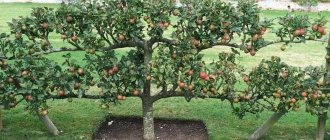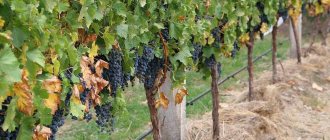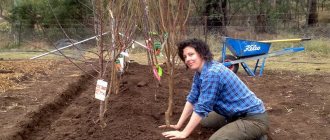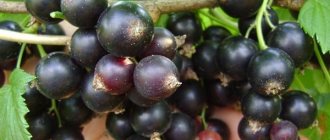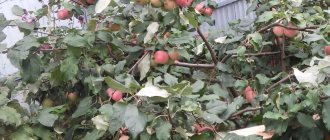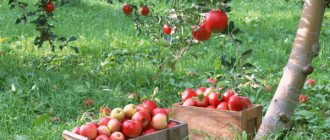Gardening » Apple tree
0
542
Article rating
Kira Stoletova
Growing apple trees in Siberia is not an easy task; you need to know the planting features, choose the right variety, and care for it properly. Let's look at all the nuances of this process and determine how to protect the fruit tree from harsh weather conditions.
Rules for planting apple trees in Siberia
Suitable varieties for Siberia
Apple trees grown in Siberia must meet the following criteria:
- have a powerful root system;
- quickly adapt to harsh growing conditions;
- ripen in a short time;
- recover from illnesses in a short time;
- be resistant to severe frosts.
According to the degree of winter hardiness, apple trees are divided into three groups:
- highly winter-hardy, growing freely at temperatures of – 40 °C;
- medium-winter-hardy, withstanding temperatures down to -35 ° C;
- weakly winter-hardy, able to survive temperature drops of no more than -25°C.
Siberian apple trees are characterized by resistance to scab damage and extremely low temperatures. Varieties recommended for planting in harsh regions include:
- Ranetka Ermolaeva . A summer, disease-resistant variety, distinguished by small yellow-red fruits with a short shelf life (up to 30 days). The first harvest can be seen approximately 4 years after planting.
- Ermakovskoe mountain . The apple tree begins to bear fruit in the 4th-5th year, at the end of August. The yield of this variety is moderate; the green-red fruits are stored for no more than a month, so they are used for processing and preservation.
- Altai Bagryanoye . The yield of each tree is up to 40 kg of small, juicy, purple apples that can be stored for up to 2 months.
- Gornoaltaiskoe . This variety has a moderate but stable yield. The shelf life of small red-blushed fruits is up to 3 weeks.
- Zhebrovskoe . The variety is the earliest in the regions of Siberia; its yellow-red apples are characterized by: juicy pulp, pleasant sourness and rich aroma.
- Melba . One of the most popular species among gardeners. Despite the fact that it does not have too high resistance to low temperatures, it successfully withstands harsh winters when covered with high-quality agrofibre. The variety is early ripening and is used on an industrial scale. Each fruit weighs up to 150 g, has very juicy pulp and a sweet taste with a slight sourness.
- Surkhurai . A fairly common variety in the Siberian regions. The fruits have a golden color, excellent taste, and each weighs about 100 g.
The following varieties are also well suited for planting in Siberia:
- White filling;
- Alyonushka;
- Bayana
- Tolunay;
- Ural liquid;
- Anise purple;
- Lungwort;
- Minusinsk red;
- Altai souvenir.
Regional climate and soil characteristics
St. Petersburg is located in the north-west of Russia in close proximity to the Atlantic Ocean. This location affects the climate. The region and St. Petersburg have high humidity and it often rains. Most of the precipitation falls in summer. The Atlantic is adjusting air temperatures. In summer it is cooler here than in the central zone, and in winter it is warmer. The Arctic approaches the Leningrad region from the north. Because of this, cold arctic air sometimes penetrates the region. In winter there are severe frosts, in summer the air temperature often drops to frost.
Melba apple tree: description of the variety, photos, reviews The Melba apple tree has been known all over the world for more than a hundred years. The variety originates from Canada. Subsequently, Melba became the progenitor of more than 20 new varieties of apple trees. Thanks to a bountiful harvest...In St. Petersburg and its environs, the soil is peaty or podzolic, poor in nutrients. Waterlogged and swampy areas are common. The layer of fertile soil is very thin. Not every variety of apple tree grows and bears fruit in such difficult conditions.
For successful establishment, it is important to choose the right time for planting the seedling.
Selecting a site for planting
The ideal place for growing Siberian apple trees would be a site on the south side, located on an inclined surface, which will prevent stagnation of moisture and rotting of the root system.
Basic requirements for the place where apple trees will be planted:
- good sunlight exposure;
- location that excludes the penetration of gusty winds;
- saturation of the soil with nutrients necessary for life.
If there are no conditions favorable for growing apple trees in a particular area, you can provide the trees with everything they need on your own: add fertilizer to the soil, build a fence from the wind, and protect them from groundwater using drainage.
Useful tips
Some tips for residents of regions with different climatic conditions:
Tip No. 1 - in the fall, in the Lipetsk region, apple trees on a dwarf rootstock take root best, since their fibrous roots do not reach groundwater.
Tip No. 2 - autumn hilling with earth will help protect fruit trees planted in the Volga region from freezing; local residents also practice insulating tree trunk circles, first with manure and then hilling with snow.
Tip No. 3 - the place for planting a seedling in the climatic zone of the Urals and Siberia is chosen on the southern side of the site, protected from winds from the north; When persistent cold weather sets in, the seedling should be tied with spruce paws.
Tip No. 4 - you should not experiment with autumn planting of large-fruited varieties in Siberia, since the probability of the death of the apple tree is almost one hundred percent.
Tip No. 5 - the advantage of planting seedlings in autumn in any climate zone is that there is less subsidence of the land under the plant.
Important: Planting seedlings in autumn and replanting completely mature apple trees is not an easy task.
Unpredictability of weather, natural surprises and sudden climate changes further complicate this important process for every gardener.
The correct choice of place to plant an apple tree determines success.
But, despite this, the key to success is still the correct choice of planting site, careful varietal selection, adherence to the timing of planting apple trees in the fall, daily care and a great desire to grow a real apple orchard on your site.
Preparation for transplanting seedlings
Growing an apple tree from seeds is a long process and low yield. Therefore, seedlings suitable for harsh regions are purchased for planting. It is best if their age varies from 1 to 3 years. It is advisable to purchase zoned varieties with a completely closed root system. If planting is planned on a small area of land, then preference should be given to columnar varieties.
It is recommended to plant seedlings in the spring, this will allow them time to adapt and get stronger before the onset of cold weather.
Before planting, the roots of the seedlings should be placed in a mixture with diluted rootstock for a day. The right time for spring events is from the second half of April to mid-May. The interval between planted trees should be at least 4 m.
Preparing a hole for planting an apple tree
For spring planting of apple trees, holes are dug 2-3 months in advance. It is advisable to prepare not only the hole, but also the soil around it, since the root system absorbs the substances necessary for growth from the entire area of the site. In some varieties of apple trees, the roots grow up to 12 m wide. You can get a good harvest from these trees only on fertile lands with neutral characteristics.
Before digging the soil, you need to moisten it a little.
It must be taken into account that the distance of the root system from groundwater must be at least 2 m, otherwise the roots will rot. If the groundwater lies higher, you must first make an embankment (with a height of 1 to 1.5 m), and only then dig a hole. Standard pit depth varies from 1 to 1.2 m in diameter and from 0.4 to 0.6 m in depth.
Clay soil
When planting a seedling in clay, the hole must be prepared with a large width and shallow depth; in a sandy area it must be slightly narrowed and deepened.
Since heavy clay soil contains few useful substances and does not drain water well, a year before planting apple trees it must be supplemented with several components calculated per 1 m2:
- river sand – 50 kg;
- sawdust – 15 kg;
- peat soil, humus, ready-made compost and manure – 15 kg;
- slaked lime – ½ kg.
Such a composition will make the soil light and well-permeable to air, which will have a beneficial effect on the growth and development of apple trees. For good adaptation of seedlings, it is recommended to add the following elements during the preparation of the hole:
- nitroammophoska – 150 g;
- superphosphate – 70 g;
- Potassium sulfate – 50 g.
They all need to be dug up ½ meter deep.
Peat land
When planting apple trees in peat soil, it is recommended to add slaked lime, chalk or dolomite flour, which will reduce the high level of acidity that is unsuitable for the growth of these trees. For 1 m2 of peat plot you need to distribute:
- 150 g superphosphate;
- 2 kg cow dung;
- 50 g potassium sulfate;
- 200 g phosphate rock.
The components must be dug up with soil to a depth of 25 cm.
Sandy soil
Planting seedlings in sandy soil requires the introduction of a number of elements, followed by digging them up to a depth of 50 cm:
- 50 kg of clay;
- 40 g potassium;
- 0.7 kg lime;
- 15 kg of organic matter;
- 70 g superphosphate.
At the bottom of the hole you need to lay out drainage from silt, or use clay for this purpose.
How to plant an apple tree in the country. When to plant an apple tree in spring, in what month: timing
The optimal time for planting an apple tree in a permanent place in the spring is the period before the buds on the tree open (i.e., the plant should still be dormant).
At the same time, an important condition for spring planting is a positive air temperature, not only during the day (it should already be +5), but also at night.
You should not wait for the ground to completely thaw; it is very good to plant seedlings with an open root system immediately after the snow has melted, but the ground has not yet had time to warm up much.
Thus, it is very advisable to have time to plant while the seedlings are still “in the dormant stage”, otherwise this will certainly negatively affect their survival rate and disrupt the natural development cycle.
As for the approximate timing, depending on the climatic characteristics of the region, spring planting of apple trees is recommended from the end of March-April to the beginning of May.
Advice! The best time to plant seedlings is cloudy and windless weather, early morning or late evening.
When is it better to plant - in spring or autumn?
It is believed that it is still better to plant all fruit trees, including apple trees, because... During this period, only roots grow by plants, which means that the seedling will definitely not vegetate. Moreover, it is recommended to do this before the onset of stable frosts, i.e. you should have about a month (3-4 weeks) left.
Important! Planting an apple tree too early in the autumn is also not recommended, because... The shoots must have time to ripen well in order to successfully survive the winter. However, if you are late, and frosts are expected within 1-2 weeks, then it is better to play it safe and postpone planting the apple tree until spring (you can save the seedling by digging it in the garden, or planting it in a container and putting it in the basement)
However, if you are late, and frosts are expected within 1-2 weeks, then it is better to play it safe and postpone planting the apple tree until spring (you can save the seedling by digging it in the garden, or planting it in a container and putting it in the basement).
Thus, the approximate dates for planting apple trees in the fall in different regions are the second half of September - the end of October.
By the way! It is also believed that pome crops - apple trees and pears - are best planted in the fall, and stone fruit crops - cherries, plums, apricots - in the spring.
In general, due to the fact that the apple tree is a fairly winter-hardy crop, it can be planted both in autumn and spring.
However, planting an apple tree in spring also has its advantages:
- Throughout the season, you will have the opportunity to respond in a timely manner to any negative factors that impede the development of the seedling (drought, diseases, pests) and take measures to eliminate them.
- A sufficient amount of moisture in the soil in the spring improves the survival rate of the tree, which shortens the period of its adaptation to the new location.
- When planting in spring, you can prepare the site and planting hole in advance (in the fall), the soil in which will completely settle by spring, and therefore the possibility of deepening the root collar of the seedling will be eliminated.
Thus, when planted in spring, the apple tree has an excellent chance of getting stronger during the season and being well prepared for the coming winter.
Note! Apple tree seedlings with a closed root system can be planted all year round - from April to October, although it is not recommended to do this in the middle of summer, when it is very hot
Spring planting dates in different regions
Naturally, depending on climatic conditions, the timing of spring planting of apple trees in different regions will differ:
- So, in the south of Russia you can plant an apple tree in the second half of March-early April.
- But gardeners in the Middle Zone (Moscow region) should wait until the 2nd decade of April.
- In Siberia and the Urals, apple tree seedlings should be planted in open ground only in late April-early May.
The lunar calendar can help you choose the optimal date for planting seedlings.
Thus, favorable days for spring planting an apple tree in 2019, according to the lunar calendar, are:
in April - 11-17; 21-26.
Yes, this is not a mistake; according to the lunar calendar, seedlings of fruit and berry crops are recommended to be planted only in April.
Of course, it is not always possible to get to the dacha on the appropriate days, so the main thing is not to plant an apple tree or any other crops on unfavorable dates according to the lunar calendar (and these are the periods of new moon and full moon).
The unfavorable days, according to the lunar calendar, for 2022 for planting apple tree seedlings in the spring are the following dates:
- in March - 6, 7, 21;
- in April - 5, 19;
- in May - 5, 19;
- in June - 3, 4, 17.
According to the lunar calendar, from the magazine “1000 tips for a summer resident.”
Landing
When choosing apple tree varieties suitable for Siberia and determining planting dates, you need to take into account the characteristics of these regions: long winters, too close groundwater, as well as a short growing season for plants.
The ideal time for planting seedlings in Siberia is spring.
There are no specific calendar days for planting apple trees in the spring, since the winter can be long, in which case you need to wait until it warms up and the snow melts. Gardening activities can begin as soon as the ground becomes soft. Early planting has its advantages: the seedling's growing season and time for adaptation are increased.
Tips for planting and care
In each climate zone, planting and caring for fruit crops has its own characteristics, knowledge of which allows you to create the most comfortable conditions for them.
Landing dates
Spring is not the most suitable time for planting apple trees in Siberia; it is best, according to experienced gardeners, to carry out planting work in the fall. Among the positive aspects of autumn planting of fruit crops are:
- rapid rooting of young trees;
- the bark and buds have time to ripen, and the already prepared plant goes into winter;
- the root system formed by winter is able to more effectively provide the crown with moisture and increase the degree of frost resistance;
- in the spring, stronger plants emerge from dormancy earlier and grow faster, in contrast to planting apple trees in the spring;
- Thanks to a full growing season, young trees are safely prepared for the coming winter and are more likely to survive it, while plants planted in spring during an unfavorable summer season are at risk of not being able to withstand frost.
For information! If you plant summer varieties of apple trees, the harvest is harvested in July, but it cannot be stored for a long time. Autumn varieties reach their harvest maturity closer to mid-September; the fruit has a shelf life of over two months.
Site selection
To plant apple trees in harsh climates, it is recommended to choose a well-lit area protected from draft winds. If there is a shortage of sunlight, then the plants will not be able to fully develop and produce a high-quality harvest. In addition, at the planting site there should not be groundwater close to the surface of the earth, at least 2.5 m before its occurrence.
Preparation
Apple trees react very sharply to depleted and heavy soil. For them, it is preferable to choose areas with fertile soil that allows moisture and air to pass through well. If the soil is highly acidic, it is recommended to use saltpeter to neutralize it.
To avoid moisture stagnation, drainage in the form of fine crushed stone and broken bricks should be placed in the planting hole.
Clay soil also has a detrimental effect on apple trees; it is better to mix it with river sand and nutrient mixtures. Thanks to this, it is possible to cultivate such soils. Loamy soils are considered an ideal option for fruit crops, where it is only necessary to periodically add fertilizer compounds to increase their frost resistance and degree of resistance to diseases.
Planting scheme
The seat should be prepared one month in advance. Dimensions: 60-65 cm in height and 70 cm in width. To plant an apple tree, you need to:
- dig a hole;
- mix the extracted soil with peat, humus, compost or a complex mineral composition;
- form a hill in the form of a mound from fertile soil;
- place the seedling and straighten its roots;
- Gently sprinkle with soil and compact lightly;
- water;
- mulch with organic matter.
For information! To support a young tree, a vertical support up to 5 cm thick is installed in the planting hole; the stake should rise at least 40 cm above the ground level.
Care Tips
For quick rooting and adaptation, the planted plant should be properly cared for:
- remove weeds near plantings;
- pour mulch into the tree trunk circle;
- carry out watering;
- do pruning;
- It is necessary to apply fertilizer mixtures only 3-4 years after planting.
Diseases
In order to prevent the development of diseases dangerous to apple trees, it is recommended not to neglect preventive measures. In addition, it is necessary to combat pests, which are often the source of diseases.
Planting scheme
A fruit tree will grow successfully in Siberia if the planting process strictly adheres to technology. The basic principles of planting are as follows:
- The best option for the climate of harsh regions would be to plant young apple trees in a hill. With the onset of warm weather, the seedling will have the opportunity to quickly warm up, which will prevent rotting of its root collar. It is best to prepare the hill in the fall; its recommended height is 30 cm.
- In the spring, pour a small amount of wood ash and a bucket of compost onto the prepared hill, and then mix everything with the soil.
- Plant the tree so that its root collar rises slightly above the soil level.
- Water the seedling using 3 buckets of well-settled water.
- Tie the planting to a stake driven nearby so that the wind does not break it.
- Perform mulching. For this procedure you need to use organic substances. The best options would be hay and straw, since microorganisms that feed the apple tree actively develop in such an environment.
Trimming
As a rule, apple trees in Siberia are pruned by cutting a side branch at an angle of 45°, without leaving a stump. This method has several advantages:
- the possibility of changing the direction of growth;
- acceleration of growth;
- crown thinning.
In rare cases, a ring cut is made, in which case the annual shoot or branch is completely removed. Using this technology, it should be remembered that inflicting 2-3 wounds on a tree close to each other most often leads to the death of the entire branch or the apple tree as a whole.
Pruning in Siberia is carried out in spring, guided by several rules:
- in case of severe freezing of apple trees in winter, the procedure is carried out no earlier than May-June, after the regrowth zone appears;
- the resulting wounds are treated with garden varnish.
Fertilizers
Adding fertilizer to the soil is an important step in the process of caring for apple trees, this is especially true during the first period of seedling growth. During the growing season, trees need to be fed at least 3 times. For this purpose, you can use complex organic fertilizers of any kind, for example:
- bird droppings (dry or diluted in water);
- mullein;
- compost.
It is recommended to use mineral fertilizers containing nitrogen:
- ammonium sulfate;
- potassium sulfate.
Protection from diseases and pests
Siberian apple trees are not prone to various diseases. The exception is getting burns from the sun and low temperatures. To prevent such a problem, it is recommended to use whitewash; it is permissible to whitewash the trunks with it already with the first warming. To combat harmful insects, spraying with plant and bacterial agents, such as:
- fitoverm;
- infusion of onion or chamomile;
- a decoction of wormwood, prepared in a ratio of 350 g per 10 liters of water.
The spraying procedure is performed after flowering has ended, and a week later it must be repeated.
To eliminate scab damage to leaves, it is recommended to use the homeopathic composition “Healthy Garden”; the rules for its use are indicated on the manufacturer’s packaging.
Growing apple trees in harsh regions cannot be called an easy process due to the high risk of freezing and death of fruit tree seedlings. However, a competent approach to this matter, care, protection from Siberian frosts and maintenance significantly increase the chances of having your own garden and reaping a good harvest from it.
Previous
Planting apple trees
